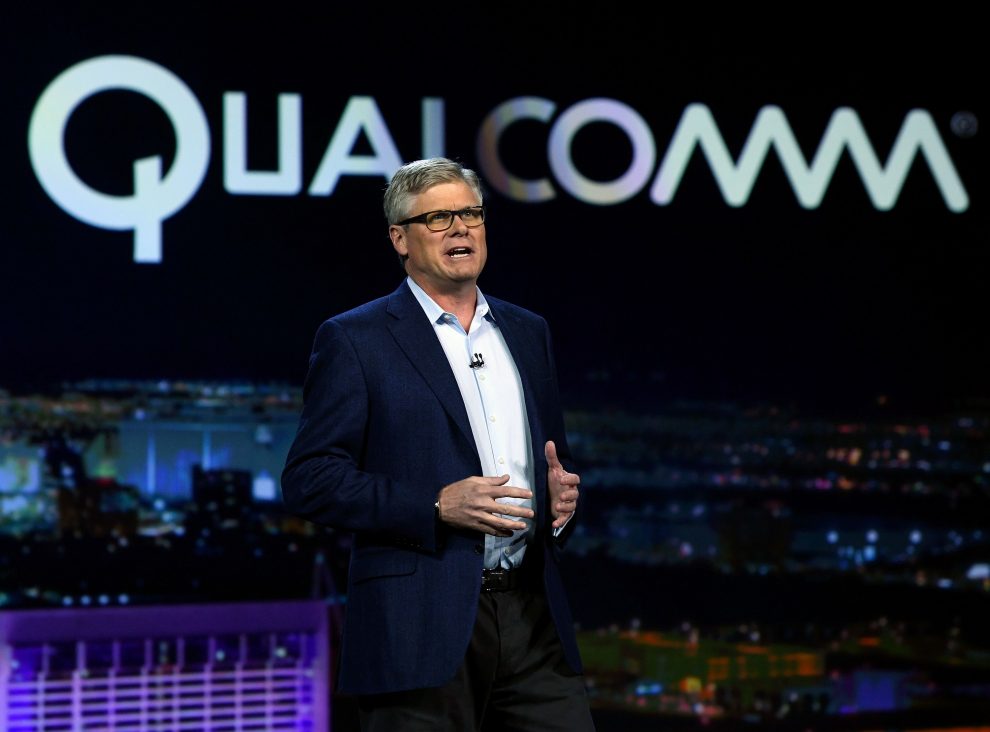
Qualcomm Inc. CEO Steve Mollenkopf speaks during a keynote address at CES 2017 on January 6, 2017 in Las Vegas, Nevada.
Ethan Miller | Getty Images
Qualcomm disappointed Wall Street with its latest financial report. According to the company, a large part of the blame falls on Chinese tech giant Huawei.
The U.S. chipmaker reported revenue for the June quarter that declined 13% year-on-year, net income that was down 34% and guidance for the September quarter that missed market expectations.
Qualcomm’s press release cited “slower demand for 4G devices as the market prepares for the global transition to 5G” as a key reason for the weakness in its results, but the follow-up earnings call with the company’s top executives heavily focused on Huawei and China as a major factor.
“The Huawei export ban, along with the pivot from 4G to 5G, which accelerated over the past couple of months, has contributed to industry conditions, particularly in China, that we expect will create headwinds in our next two fiscal quarters, ” Steve Mollenkopf, CEO of Qualcomm, said on Wednesday.
“As a result of the export ban, Huawei shifted their emphasis to building market share in the domestic China market, where we do not see the corresponding benefits in product or licensing revenue.”
China’s Huawei was put on a U.S. blacklist that restricted American firms from selling products to it. Huawei relies on American components for products from smartphones to laptops. President Donald Trump’s administration later said that U.S. firms could sell to Huawei in instances where there are no national security risks.
As a result of the restrictions on Huawei, the Chinese technology firm has turned its focus to China and increased its smartphone market share in its home country. Huawei shipped a record high number of smartphones in China in the second quarter and the country accounted for 62% of its total shipments, according to data from market research firm IDC. Huawei was the largest smartphone player by market share in China in the second quarter, according to separate data from another research company, Canalys.
The reason Mollenkopf said that Qualcomm didn’t see “corresponding benefits in product or licensing revenue” is because Huawei makes the majority of its own smartphone modems. Therefore, the rise in Huawei’s China shipments didn’t help Qualcomm. But the U.S. firm does supply to Huawei’s rivals such as Xiaomi and Oppo, both of which saw declines in smartphone shipments in the second quarter in China, according to Canalys. So Huawei’s gain hurt Qualcomm.
Huawei is pushing ahead with its own chip technology in both processors and modems. It has developed a chip called the Kirin 980 which is both processor and modem. The processor powers the device while the modem allows it to connect to mobile networks. Huawei has already released its own 5G modem as well. The Chinese firm does still buy Qualcomm modems, but that percentage is low, and it is likely to try to wean itself completely off those.
Qualcomm rival Intel also warned of a slowdown in the China market.
“The China market for us has slowed and it’s had an impact on how we see the full 2019 playing out as demand signals (and the) overall economy in China slowed and then demand signals for semi equipment and for our business in particular slowed as a result of slowing demand,” Bob Swan, CEO of Intel, told CNBC on Wednesday.
Swan also said that the company has submitted “quite a few licenses” to the U.S. government for approval to sell to Huawei. Intel supplies some processors for Huawei laptops.
Qualcomm-Huawei royalty dispute
One reason Qualcomm’s shares slid over 5% in Wednesday’s after-hours trade was because the company missed guidance expectations for the quarter ending in September.
Qualcomm said that its fiscal fourth-quarter guidance excludes “revenues for royalties due on sales of products by Huawei,” which may have contributed to the miss.
That’s because the two sides are currently in a dispute over royalties. Huawei has allegedly been withholding royalties from Qualcomm. In January, Huawei and Qualcomm struck an interim agreement which saw the Chinese firm pay some of the royalties it was said to have owed.
“With regards to Huawei, we continue to pursue a negotiated resolution of the dispute, focused on a final agreement,” Mollenkopf said.
Qualcomm has been criticized by Apple for its licensing practices and the two were locked in a legal battle for several years. Apple accused the company of using its dominant position in the smartphone modem market to charge very high royalties. Qualcomm has contended this is not the case and that there is adequate competition in the market. Both sides settled the dispute in April.
However, in a separate case earlier this year, U.S. District Judge Lucy Koh ruled in favor of the Federal Trade Commission in its legal pursuit of Qualcomm. The judge said Qualcomm “strangled competition” through its licensing practices and asked the chipmaker to renegotiate some contracts with customers. Qualcomm is now appealing the decision.
‘Snap back’
Despite Qualcomm’s troubles with Huawei and the Chinese market, its CEO struck an upbeat tone. He called Huawei’s big focus on China “unusual” and said that Qualcomm will “snap back” as companies begin to release 5G smartphones in 2020.
5G refers to the next generation of mobile networks that promise high data speeds and low latency — minimal delay between requesting and receiving data — which could underpin technologies such as driverless cars.
Many networks around the world are beginning to roll out 5G with major players including Samsung and Huawei bringing 5G-capable devices onto the market. Qualcomm President Cristiano Amon said that will help the company compete despite rising competition, even in China.
“I think we have competed with many other companies throughout the years and we are optimistic about the lead we have on 5G and hopefully that will drive a good transition with our customers in China, including competing with Huawei domestically as well,” Amon said on the conference call.






